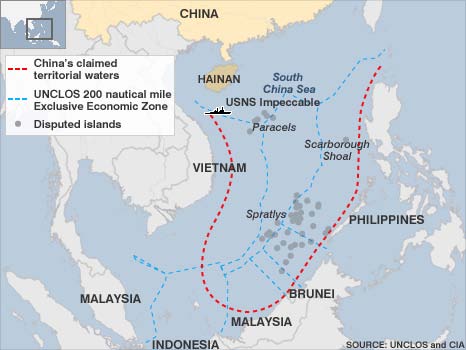
As international attention focuses on resolving issues on the Korean peninsula, trouble is brewing in a different Asian arena. The South China Sea is one of the world’s busiest shipping routes, an extremely productive fishing area, and is reported to contain vast deposits of oil and natural gas. The Sea is bordered by Brunei, China, Indonesia, Malaysia, the Philippines, Taiwan, and Vietnam, each of which claim all or part of the Sea. After several quiet years, unresolved sovereignty issues and competition over resources are increasing political tension. For Asian countries in the midst of a period of high economic growth, the South China Sea is set to become a core national security concern.
Fossil fuel exploration in the South China Sea has been minimal so a reliable figure for proven oil and gas deposits is unavailable. One Chinese study enthusiastically predicted undiscovered reserves totaling 213 billion barrels, while a U.S. Geological Survey in 2000 put the figure at 29 billion barrels. Another Chinese estimate of the Paracel and Spratly Islands alone put potential deposits at 105 billion barrels. Sinopec, in cooperation with the Norwegian energy group Statoil, is currently working on a comprehensive seismic study of a 1,250 square kilometer area near the Paracel Islands. Results are expected later this year.
Several studies have shown that natural gas, not oil, is the most abundant fossil fuel in the South China Sea. The U.S. Energy Information Administration, citing several previous studies, predicts total natural gas resources of 900 trillion cubic feet (tcf). In 2006, a joint exploration of the Spratly Islands by Husky Energy, a Canadian energy company, and the Chinese National Offshore Oil Corporation found proven natural gas reserves of 4-6 tcf. Husky, controlled by the Hong Kong-based billionaire Li Ka-shing, announced earlier this year that it had made its third significant gas discovery in the South China Sea and expects production from the new well to exceed 90 million cubic feet per day by 2013.
Competition over these resources is increasing. The Paracel and Spratly Islands are claimed by China, Malaysia (three islands), the Philippines (eight islands), Taiwan, and Vietnam. Official Chinese maps extend China’s territorial waters to include the Natuna Islands, where Indonesia has held large-scale military exercises and operates offshore natural gas platforms. Meanwhile, two Filipino projects are operating in waters claimed by China, and Taiwan, which already occupies several contested islands off the coast of Hong Kong, has announced its intention to build an airstrip on Taiping Island near the Spratlys.

It is interesting to compare the South China Sea, which has no reliable figures of proven oil and natural gas deposits, to other energy-rich regions. Only five countries have proven reserves over 100 billion barrels of oil and only Saudi Arabia tops 200 billion barrels. Estimates of the South China Sea reserves reach 213 bbl. Regarding natural gas, only Russia and Iran have proven reserves of over 1,000 tcf; the South China Sea could contain up to 2,000 tcf, according to several Chinese studies. Comparing proven reserves of energy-rich countries to the minimally explored South China Sea is not an entirely accurate evaluation but it does highlight the critical role this area will come to play as Asian countries continue to lead global demand for energy. Reliable estimates of oil and gas deposits this close to home could change the way countries like China and India pursue their energy supply.
Since November 2002, the Declaration on the Conduct of Parties restricted territorial expansion in the South China Sea and ensured that sovereignty disputes were resolved peacefully. Recently however, China has stepped up its claims to the area. Despite protests from Vietnam, China will again enforce a summer fishing ban over the entire South China Sea, including areas that Hanoi considers under its direct sovereignty. Eight Chinese fisheries patrol ships enforced the ban last year and in April of this year, two vessels escorted private fishing boats to the Spratly Islands. Vietnam accuses China of harassing Vietnamese fishing boats in several disputed areas, including one incident this year where Chinese ships seized a Vietnamese fishing vessel near the Paracel Islands. The South China Morning Post highlights another incident involving the 4,600-tonne Yuzheng 311, China’s largest fishing protection vessel. It was “surrounded by more than 20 Vietnamese fishing and coastguard vessels last month as it attempted to stop harassment of Chinese fishing boats. The Yuzheng…was also intercepted by Malaysian naval ships and aircraft as it patrolled south of the Spratlys late last month.”
Fishing rights are likely to become an increasingly tense issue between China and other countries bordering the South China Sea, all of which are among the world’s largest fish and shellfish producers. In harassing foreign vessels and enforcing a summer fishing ban, China is taking charge of regional ocean governance and establishing a pattern for control over resources in areas of disputed sovereignty.
Chinese fisheries patrol vessels are not the only tools China uses to emphasize its claim over the South China Sea. A navy flotilla embarked on a training exercise in March that lasted several weeks and circled disputed areas including the Spratly and Paracel Islands. During a short stay in the Spratlys, the navy coordinated combat training and mock bombing exercises with land-based aircraft. Another flotilla simultaneously set off to the East China Sea and conducted antisubmarine exercises near the Okinotori atoll, a group of islands lying between Taiwan and the strategically important U.S. base on Guam. Beijing, though still far outmatched by the U.S. navy, is demonstrating a determination to expand its naval defense perimeter.
These exercises are part of China’s new “far sea defense” policy, a shift in previous naval doctrine that focused on coastal protection. Chinese economic development and population growth has resulted in a concerted effort by Beijing to directly control access to energy and other resources. This policy is increasingly evident in the South China Sea where the navy patrols disputed territories despite protests from its neighbors.
Oil and natural gas deposits in the South China Sea could be enormous and, if under direct Chinese control, would represent a major source of domestic energy supply. Recent military exercises signal a desire to control several contested areas. Efforts to coordinate exploration and extraction by national and international energy companies are underway and should be increased. Nevertheless, regional governments and the U.S. Pacific Command should be wary of Chinese resource-driven expansionism in the near future.